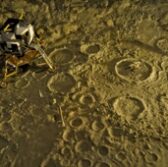 NASA has picked nine out of 33 scientific instrument proposals for the agency’s planned space mission to investigate whether the structure of a Jupiter moon could support life.
NASA has picked nine out of 33 scientific instrument proposals for the agency’s planned space mission to investigate whether the structure of a Jupiter moon could support life.
The agency said Monday it aims to build and put a solar-powered spacecraft into orbit around Jupiter for three years to study the planet’s Europa moon.
Participants proposed camera and spectrometer systems to examine the giant planet’s lunar surface and components, a radar to measure thickness of Europa’s ice and a magnetometer to assess its magnetic field.
“We’re excited about the potential of this new mission and these instruments to unravel the mysteries of Europa in our quest to find evidence of life beyond Earth,” said John Grunsfeld, associate administrator for NASA’s science mission directorate.
According to NASA, the Jupiter space probe Galileo observed an ocean that lies beneath Europa’s frozen crust, while the Hubble Space Telescope detected water vapor above the moon’s south polar region.
The principal investigators of the nine NASA selectees come from Johns Hopkins Applied Physics Laboratory, NASA’s Jet Propulsion Laboratory, the University of Texas, Arizona State University, University of Colorado and the Southwest Research Institute.




